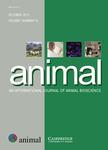版权所有:内蒙古大学图书馆 技术提供:维普资讯• 智图
内蒙古自治区呼和浩特市赛罕区大学西街235号 邮编: 010021

作者机构:Univ Edinburgh Global Acad Agr & Food Secur Edinburgh EH25 9RG Midlothian Scotland Embrapa Agr Informat BR-13083886 Campinas Brazil Univ Edinburgh Sch Math Edinburgh EH9 3FD Midlothian Scotland Texas A&M Univ Dept Anim Sci College Stn TX 77843 USA
出 版 物:《ANIMAL》 (动物)
年 卷 期:2020年第14卷第Sup2期
页 面:S257-S266页
核心收录:
学科分类:0905[农学-畜牧学] 0906[农学-兽医学] 09[农学]
基 金:University of Edinburgh's Data-Driven Innovation Chancellors fellowship Economic and Social Research Council (ESRC) [ES/N013255/1] CAPES Foundation [10180/13-3] BBSRC [BB/T004436/1] Funding Source: UKRI ESRC [ES/N013255/2, ES/N013255/1] Funding Source: UKRI
主 题:linear programming nonlinear programming ration formulation optimization feedlot
摘 要:Feeding cattle with on-pasture supplementation or feedlot diets can increase animal efficiency and system profitability while minimizing environmental impacts. However, cattle system profit margins are relatively small and nutrient supply accounts for most of the costs. This paper introduces a nonlinear profit-maximizing diet formulation problem for beef cattle based on well-established predictive equations. Nonlinearity in predictive equations for nutrient requirements poses methodological challenges in the application of optimization techniques. In contrast to other widely used diet formulation methods, we develop a mathematical model that guarantees an exact solution for maximum profit diet formulations. Our method can efficiently solve an often-impractical nonlinear problem by solving a finite number of linear problems, that is, linear time complexity is achieved through parametric linear programming. Results show the impacts of choosing different objective functions (minimizing cost, maximizing profit and maximizing profit per daily weight gain) and how this may lead to different optimal solutions. In targeting improved ration formulation on feedlot systems, this paper demonstrates how profitability and nutritional constraints can be met as an important part of a sustainable intensification production strategy.